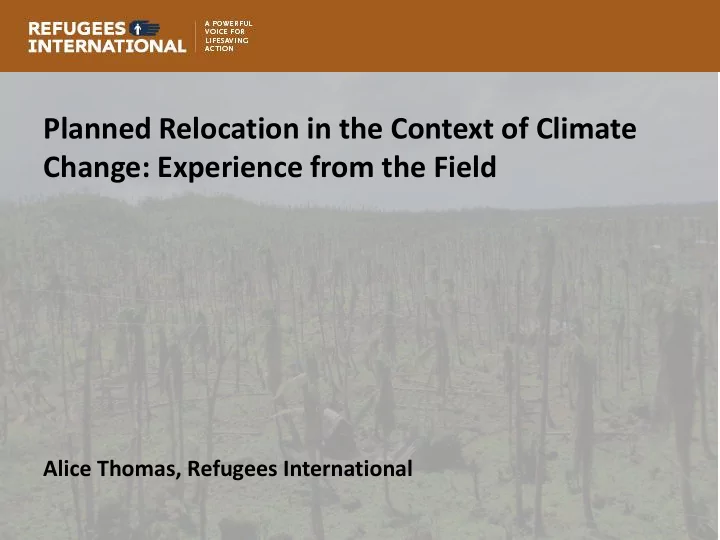

Planned Relocation in the Context of Climate Change: Experience from the Field Alice Thomas, Refugees International
The Politics of Planned Relocation Toolbox is “particularly relevant to situation where there is time to plan and on planned relocation as a proactive measure to respond to risks created by disasters and environmental change.” Toolbox, p. 4 Challenges to engaging in proactive relocation: • Limited amount of climate risk information available to local governments & local communities; • Limited funding or alternative land available for planned relocation, even where need is recognized; • Those most vulnerable to climate change effects and displacement, and therefore in need of planned relocation, are often the poorest and most disenfranchised; and • Often people don’t want to move.
2013 Typhoon Haiyan in the Philippines Photo credit: Refugees International
2013 Typhoon Haiyan – Local governments well aware of hazard risks before disaster 4 million people displaced Primarily coastal communities who lacked secure land rights Govt institutes relocation plan for 200,000 households (1 million people) Relocation plans adopted by government ran into obstacles including: Lack of suitable, available land for relocation Lack of sufficient funding Lack of legal & institutional framework for relocation Result: Protracted displacement of vulnerable HH in camps, bunkhouses Only small % of households relocated Relocated HH experience loss of livelihoods, access to social services, social networks Most people went right back and more vulnerable than before; risk of recurrent displacement
2015 Flooding and Landslides in Myanmar
2015 Floods & Landslides – Affected 9 million people primarily in Rakhine and Chin States Areas affected extremely poor & vulnerable Humanitarian response to disaster insufficient Inability of houses to recover (e.g., increased poverty; indebtedness) Relocations: Collapse of river banks and landslides resulted in permanent displacement Govt, with support of intl agencies, relocates communities Ran into same challenges: lack of land, funding, legal frameworks Result: Protracted displacement of vulnerable HHs awaiting relocation Mixed results in terms of sustainability Likely migration over long term
Outcomes: - People moved to remote locations - Lacked access to livelihoods/services - New sites often more dangerous - Poorer than before - No consultation/participation of communities
Takeaways: • Post-disaster relocation largely unsuccessful • Prolonged displacement • Secondary displacement • Protection issues unaddressed (e.g., evictions) • People left more vulnerable than before
Lessons Moving Forward National Governments: Insufficient focus on preventing/mitigating conditions likely to bring about displacement and threaten human rights. Need to develop and implement human rights-based disaster management laws that focus on identifying & addressing climate displacement risk (e.g., hazard and vulnerability mapping; early warning; evacuations). Implement legal & institutional frameworks for planned relocation. International Humanitarian Agencies: Need to understand/clarify their role in planned relocation. International Development Agencies: More focus on disaster recovery. Integrate climate displacement risk into laws and development planning including DRM, land use planning, building codes, agriculture, climate change adaptation.
Thank you!
Recommend
More recommend